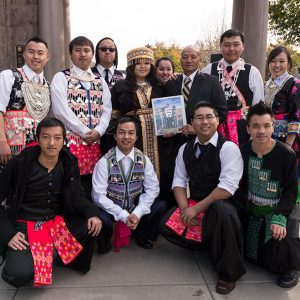calsfoundation@cals.org
Hmong
The Hmong are an ethnic group from Southeast Asia, and their presence in Arkansas stems from the evacuation of allied groups by the U.S. government at the end of the Vietnam War. As of the 2010 federal census, there are 2,143 Hmong residents of the state, concentrated in northwestern Arkansas.
Prior to the Vietnam War, little was known in the West about the thousands of tribes of hill people throughout Southeast Asia, mostly peasants with ancestry going back to China, Laos, Vietnam, and Thailand. During the Vietnam War, one of these groups, the Hmong, was sympathetic to the American forces, but circumstances did not allow the Hmong to obtain legal status in Thailand at war’s end. Even before the fall of Saigon, over six million Southeast Asian refugees had been displaced. In the spring of 1975, when U.S. forces withdrew from Vietnam following the communist takeover of the country, many of the Hmong fled to the mountains of Laos to avoid the persecution and inhumane treatment they were experiencing because they had assisted the American forces. This mistreatment was a serious issue, and, initially, the allies hoped to resettle them in safer areas of their home nations, but this was quickly dismissed as impossible.
On May 23, 1975, President Gerald Ford signed the Indochina Migration and Refugee Assistance Act. Under this act, 65,000 displaced people were evacuated by the U.S. military, and an additional 65,000 others who had made their way to the United States by other means were allowed to enter the country under a special status. In the United States, four temporary immigration centers were established. They included Eglin Air Force Base in Florida, Camp Pendleton in California, Fort Chaffee in Arkansas, and Fort Indiantown Gap in Pennsylvania.
Every refugee underwent security checks, and individuals with a criminal history or those guilty of offenses political in nature were not accepted. Those who made it through the screening were then the responsibility of dozens of immigration agencies, including the United States Catholic Conference, the Church World Service, the International Rescue Committee, the Hebrew Immigrant Aid Society, the Lutheran Immigration and Refugee Service, the Tolstoy Foundation, the American Council for Nationalities Services, the American Fund for Czechoslovak Refugees, and the Travelers Aid-International Social Service of America, as well as several state and city service centers. The task of these agencies was to find family members or others who would sponsor the refugees. It was important to address the language and cultural differences and provide the appropriate services.
Only a small group of Hmong were among the first group of Asian refugees to arrive in the United States, but beginning in 1979 and continuing until the mid-1990s, more than 100,000 were admitted to the United States. The 2000 federal census reported that there were more than 186,000 Hmong Americans living in the United States, with California, Minnesota, Wisconsin, North Carolina, and Michigan having the largest concentrations. According to the 2010 census, the total number of Hmong in the United States had risen to 260,076. The same census lists Arkansas twelfth in the nation in Hmong population, with 2,143 in the state, the largest numbers living in or near Gentry (Benton County) and Fort Smith (Sebastian County).
When in Thailand, the Hmong were treated as undocumented workers and were often exploited and abused by their employers. They arrived in the United states with little understanding of the workplace, employee rights, job benefits, the language, the culture, or how to improve job skills. Hmong who arrived after the initial migration did have the benefit of joining relatives who were some of the first to be evacuated. The Hmong have a clan-based culture, and they often seek to live with or near other family members. Unlike the first surge of evacuees, the next group had no international assistance. They could not depend on humanitarian agencies for their basic survival.
Several Hmong from across the country came to Arkansas in 2004 when they learned that Tyson Foods, a chicken-processing company, was offering land and poultry farms. They were farmers in their home countries, and chickens had a special place in their culture. However, a lack of understanding of poultry industry regulations, combined with poor earning potential in the poultry industry, limited their success, and many left the farms and found employment in other areas. Those who remain have become more financially independent and are assimilating into the population.
In June 2006, Hmong Association, Inc., was formed by several Arkansas clan leaders involved with the poultry industry. The association has developed an online newsletter explaining its mission, which is to build stronger families and communities through education and family counseling. Due to a lack of funding, the programs are run by volunteers. Working with local, state, and federal agencies, they also counsel the Hmong on health issues and employment opportunities.
For additional information:
Downing, Bruce T. “The Hmong Resettlement Study: Site Report, Fort Smith, Arkansas.” Washington DC: U.S. Department of Health and Human Services, Social Security Administration, Office of Refugee Resettlement, 1984. Online at http://catalog.hathitrust.org/Record/009891210 (accessed November 8,, 2021).
Pierce, Charles P. “How to Become an American.” Sports Illustrated, December 12, 2011. Online at https://www.si.com/vault/2011/12/12/106139388/how-to-become-an-american (accessed November 8, 2021).
Potts, Monica. “The Serfs of Arkansas.” American Prospect, March 5, 2011. Online at http://prospect.org/article/serfs-arkansas-0 (accessed November 8, 2021).
Wiggins, Melanie Spears. “Escape to America: Evacuees from Indochina Arrive in Fort Smith, 1975–1979.” Journal of the Fort Smith Historical Society 31 (April 2007): 14–29. Online at https://uafslibrary.com/fshsj/31-01_Complete_Issue.pdf (accessed November 8, 2021).
Isobel McQuiston
Hot Springs, Arkansas
 Divergent Prosperity and the Arc of Reform, 1968–2022
Divergent Prosperity and the Arc of Reform, 1968–2022 Hmong
Hmong 




Comments
No comments on this entry yet.